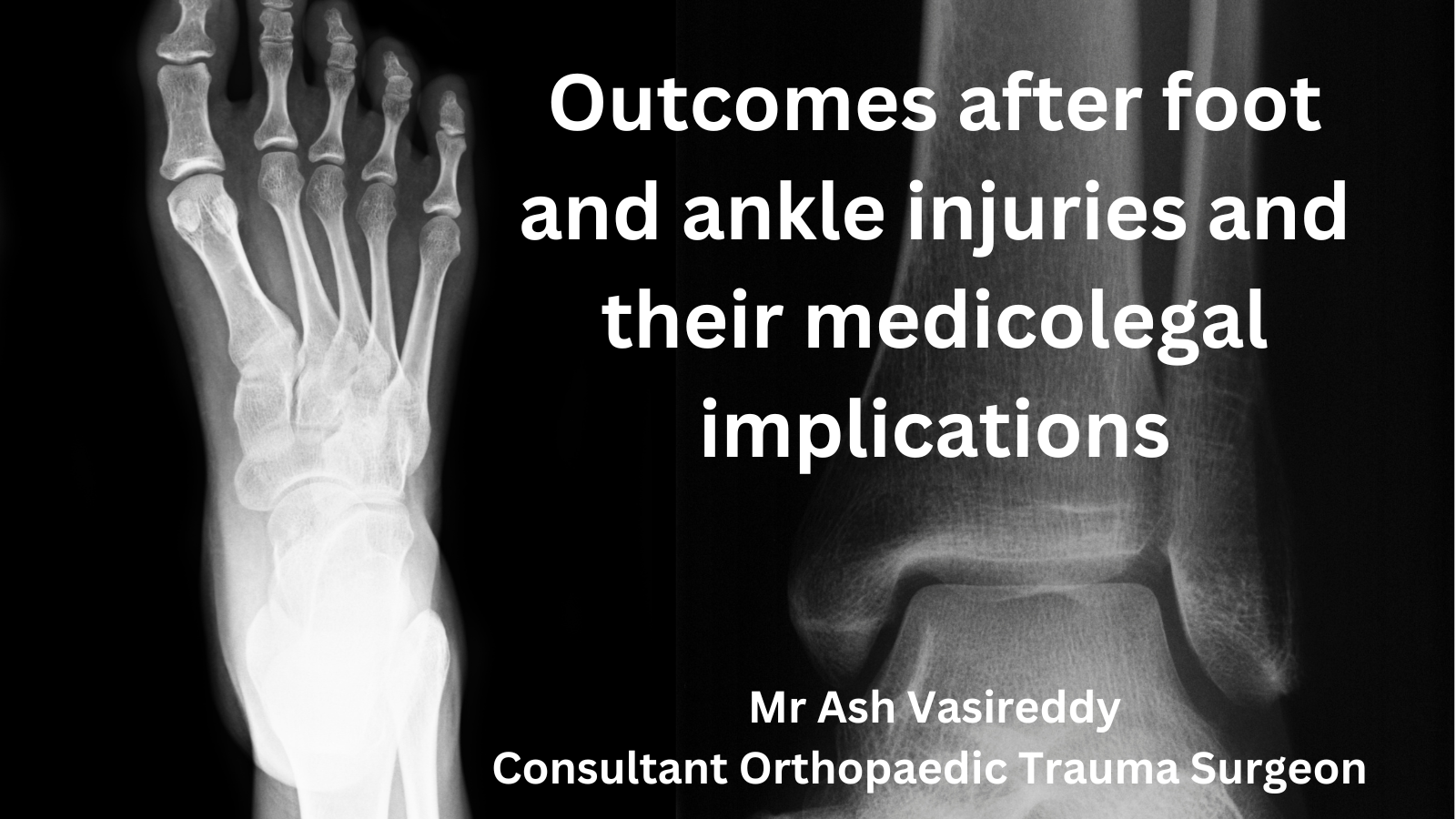Outcomes after Foot and Ankle Injuries and their Medicolegal Implications

Ankle injuries are extremely frequent: sprains account for around 5% of all Emergency Department visits in the UK each year, while ankle fractures are one of the commonest fractures to require surgical intervention. Complications arising from ankle injuries can have severe consequences for the patient, and the potential restriction in mobility can be particularly debilitating. If a good long-term outcome is to be achieved, an early accurate diagnosis is vital. It can be difficult to distinguish a fracture from a ligament injury purely from a physical examination, so imaging is essential. Careful rehabilitation after an ankle injury can also help to prevent recurrent injury and an ensuing loss of function.
Ankle fractures occur most often following a same-level fall and can range in severity from simple stable fractures to open fractures with dislocation and comminution. The latter type requires emergency treatment, usually comprising surgery, in order to prevent nerve damage and shock. Common complications following surgery include wound haematoma, necrosis of the wound edges and infection. Deep-seated infection can have devastating consequences, including amputation or even death. However, removal of infected hardware may lead to permanent disability if union of the broken bones has not sufficiently progressed. Therefore, management of an infected ankle fracture with exposed hardware can be particularly challenging.
As the incidence of ankle fractures in elderly patients with existing comorbidities is increasing, it is likely that the number of complications associated with ankle fracture surgery will also rise. Bone quality is reduced in older patients, increasing the likelihood of non-union or malalignment of the broken bones. The chronic pain and stiffness associated with malunion may lead to functional impairment of the ankle, restricting the ability to walk and take part in other physical activities.
Rehabilitation following ankle fracture can also present some difficulties. Studies have shown that patients who put weight on the affected leg soon after surgery return to work earlier than patients with no weightbearing. Early weightbearing also stabilises the ankle joint and prevents movement and rotation of the talus bone. However, early mobilisation of the ankle can increase the risk of wound complications, particularly in patients who are obese, diabetic or heavy users of alcohol or tobacco. In these patients, a longer period of non- or partial weightbearing is recommended.
While ankle sprains are often thought of as a relatively minor injury which will heal in time, complications are surprisingly common, arising in 30–50% of cases. Sprains occur when the ankle joint is twisted unnaturally and the ligaments within it are stretched and damaged. Many sprains are the result of sports-related injuries, but some also occur as the result of falling or slipping, or from walking on uneven ground. It is important that a sprain is correctly diagnosed at initial presentation. If issues such as a bone fracture, tears to the cartilage or tendon, or nerve damage are not identified, a delay in treatment can lead to chronic pain and weakness in the joint. Once a sprain has been diagnosed, the ligaments should be given sufficient time to heal properly. Incorrect healing can lead to permanently stretched ligaments, resulting in an ankle that is weak and unstable, with an abnormal range of movement. Further sprains become much more likely and can result in chronic pain, swelling and stiffness in the affected joint.
Osteochondral lesions are a common occurrence in weightbearing joints. They can range in severity from slight bruising to fractures of the articular cartilage and bone. The cause is usually a traumatic injury but initially these lesions can be subtle and present with few symptoms. Thus, the early stages of this condition are often missed. As the injury worsens, symptoms include deep ankle pain associated with weightbearing, impairment in function and range of movement, and stiffness, locking and swelling of the joint. In severe cases, a fragment of bone may become displaced and disrupt normal joint motion. The aim of treatment should be to relieve the obvious symptoms and restore the function of the joint but if diagnosis, and surgery if required, is delayed, the chances of a good outcome are reduced.
One major complication of all of the above ankle injuries is the onset of posttraumatic osteoarthritis (OA). While primary OA is relatively uncommon in the ankle, the reaction of this joint to trauma appears to be different from that of other joints, and nearly 80% of ankle OA occurs after an injury. This compares to around 8% in the hip and 12% in the knee. As well as damage to the articular surfaces of the joint, injury to the surrounding structures may lead to changes in the way the limb is used. In particular, fracture repairs that fail to preserve the alignment of the bones can lead to repetitive abnormal joint loading and malalignment which eventually results in asymmetrical joint wear and the development of posttraumatic OA. Furthermore, this type of OA tends to develop at a younger age in patients with ankle injuries compared to injuries in other joints, although the time between injury and the development of OA is also strongly influenced by the severity of the initial injury.
Further reading:
Ovaska M. (2015). Complications in ankle fracture surgery. Acta orthopaedica. Supplementum, 86(358), 1–32. https://doi.org/10.3109/17453674.2014.100227
Palmer-Green, D. S., Batt, M. E., & Scammell, B. E. (2016). Simple advice for a simple ankle sprain? The not so benign ankle injury. Osteoarthritis and cartilage, 24(6), 947–948. https://doi.org/10.1016/j.joca.2015.12.019




